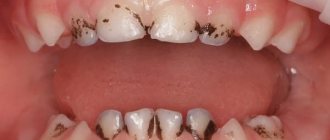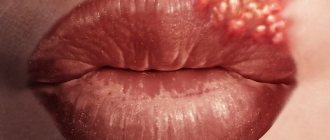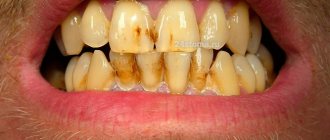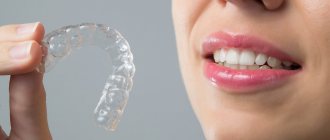Natural causes of plaque
In some cases, the phenomenon in question appears periodically and at different times of the day. In other situations, the problem is present on an ongoing basis. For example, a person may notice plaque in the morning after sleep, during which the saliva flowing from the mouth dries, forming a whitish crust. This condition passes through a certain period and should not cause alarm. But there are also dangerous pathologies that require immediate medical attention. We will list the most common provoking factors, and later in the material we will consider in more detail the main pathological causes.
- allergic reactions, which are caused, for example, by the use of toothpaste containing components that irritate the mucous membranes,
- vitamin deficiency associated with a lack of useful vitamins and microelements in the body - cracks appear in the corners of the lips, followed by a white coating,
- wearing uncomfortable or deformed orthopedic structures, which leads to injury to the mucous membrane and its drying out due, for example, to the inability to close the mouth normally,
- taking potent drugs, antibiotics, hormones and contraceptives, undergoing chemotherapy - all these factors can lead to changes in the composition of saliva and disruption of the protective functions of the oral mucosa,
- smoking and other bad habits - plaque in this case can be regarded as the first signal that it’s time to quit smoking and excessive alcohol consumption,
- dehydration of the body due to increased physical activity, as well as prolonged exposure to heat - dry mucous membranes lead to the appearance of small cracks around the lips and whitish discharge,
- problems with nasal breathing, due to which the mucous membrane often dries out, because you have to breathe through the mouth,
- prolonged depressive state - in such cases, the lower lip usually suffers mainly, on which, in addition to plaque, small pimples also appear. You need to reconsider your lifestyle, try to sleep at least 8 hours a day, or better yet, take a vacation from work and have a good rest, because the result of stress is not only plaque, but also other malfunctions in the internal systems of the body,
- poor nutrition, excessive consumption of salty, sweet, smoked, heavy and fatty foods, leading to problems such as dysbiosis, gastritis and other gastrointestinal disorders,
- systemic pathologies such as diabetes mellitus,
- viral and bacterial infections, which are most often caused by decreased immunity and poor oral hygiene.
If the plaque goes away after some time, then there is no need to worry
. It is worth noting that a light film may well be the result of using low-quality lipstick or gloss. Some cosmetic products add components that promote drying and peeling of the epithelium. To solve the problem, just stop using low-quality cosmetics.
Reasons for the formation of white plaque on the lips in adults
The causes of symptoms are divided into 2 groups:
- pathological;
- non-pathological.
Non-pathological include:
- improper oral hygiene;
- poor nutrition (eating unhealthy foods, lack of essential nutrients, etc.);
- wearing dentures;
- bad habits: addiction to smoking or alcohol;
- constant stress, depression;
- taking certain medications.
Among the pathological causes (diseases) of the appearance of a characteristic white coating on the lips in adults, the following are distinguished:
- infections;
- AIDS virus;
- tonsillitis;
- gastrointestinal diseases;
- scarlet fever;
- lichen planus;
- respiratory tract diseases;
- liver diseases;
- thrush.
White plaque is a symptom of disease
This is interesting! If a film or whitish coating appears on the lips, it is not necessary that this is the cause of some pathological process in the body.
It is necessary to analyze the patient’s condition as a whole and find out if there are any other accompanying symptoms. If they are present, you should urgently visit a doctor to avoid serious health problems.
White plaque in the corners of the lips
A common disease is candidiasis (thrush). This is a fungal pathology caused by the Candida fungus. Diagnosed if additional symptoms are present:
- presence of microcracks;
- white plaque in the corners of the lips and cracks;
- the formation of small wounds or ulcers;
- cracks until they bleed;
- itching
At the same time, a person’s physical condition deteriorates: irritability, aggression appear, appetite decreases, he becomes lethargic, and quickly gets tired.
Note! The presence of a white coating often indicates that there is a bacterial infection. If therapy is not started in a timely manner, the risk of serious complications increases, such as laryngeal thrush, the growth of small wounds into large enough erosions that are no longer so easy to cure.
If you begin to notice that white plaque begins to appear in the corners of your lips from time to time, be sure to visit a medical facility. The doctor will prescribe an appropriate medical examination, and after identifying the pathogen and accurately diagnosing the disease, prescribe the necessary complex therapy.
Plaque on lips in the morning
The most common reason for the appearance of a characteristic film after sleep is saliva spontaneously flowing from the oral cavity, which dries out and forms whitish spots on the lips.
But there is also a more insidious reason - candidal stomatitis. Fungi of the Candida class are also responsible for the manifestation of this disease. They are present in the body of absolutely every person, but they begin to multiply and cause harm only when the immune system is weakened.
White plaque with this disease forms both in the lips and in the entire oral cavity. If you let the disease take its course, it will very quickly begin to progress, causing the patient a lot of inconvenience, accompanied by painful sensations.
Pathology can only be overcome with comprehensive treatment. Therapy must necessarily include taking vitamins, as well as immunomodulatory and antifungal pharmacological agents.
White plaque on the lips in men
It is generally accepted that the problem in question worries mostly the female half, but men are no less likely to exhibit this symptom. The reasons why the stronger sex may develop white plaque on their lips are the same as described above.
However, the most common of them is the presence of bad habits. A dense white film is the least of what can cause regular smoking.
Photo 2: Inhaling toxic smoke or steam from a hookah can cause serious diseases of both the mouth and lips, and the respiratory system. Source: flickr (Eugene Li).
More about the main pathological prerequisites
As for the pathological problems that lead to the appearance of the symptom in question, most often light discharge occurs due to viral infections, lack of vitamins and microelements, and disturbances in the gastrointestinal tract. Let's take a closer look at the most common reasons for the formation of white plaque on the lips.
Localization of plaque during candidiasis
This type of disease begins to develop against the background of excessive proliferation of opportunistic yeast-like fungi of the genus Candida, which live in every organism. People call this disease “thrush”. Patients with candidiasis often complain of the following symptoms:
- redness of the mucous membrane inside the mouth,
- a cheesy, white coating on the tongue and lips, as well as on the roof of the mouth,
- the appearance of blisters, painful ulcers that cause discomfort during eating and talking,
- sensation of itching and burning at the location of the wounds,
- fatigue, lack of appetite,
- In a newborn baby, plaque often causes an increase in body temperature.
The photo shows candidiasis
. Important! If left untreated, the film acquires a brownish or greenish tint. Therefore, it is better to contact a specialist immediately after discovering a suspicious symptom.
The disease occurs against the background of such negative factors as chronic problems with the gastrointestinal tract, metabolic disorders, diabetes, stress, depression, antibiotic therapy, pathologies of the endocrine system and a sharp decline in immune defense. It is also transmitted to healthy people through kisses, personal hygiene and household items.
Thrush often occurs in women in the first trimester of pregnancy. This symptom disappears on its own, but it is still better for the patient “in pregnancy” to consult a doctor. Candidiasis is also diagnosed during hormonal imbalances, menopause, and during puberty. In a child, sometimes spots are the result of trauma to the mucous membranes and the subsequent formation of pathogenic microflora (if he hits himself or bites his lips).
If left untreated, the film acquires a brownish or greenish tint.
For candidiasis, specialists prescribe treatment, which includes a comprehensive intake of antifungal agents, application of creams and ointments. During the entire course, patients are advised to rinse their mouths with appropriate solutions.
Changes in the oral mucosa due to dysbacteriosis
An imbalance of bacteria (or dysbiosis) in the human body, provoked by taking medications and poor-quality food, often causes the accumulation of deposits on the tongue, similar to cheesy lumps. Plaque is not always easy to clean off from the outer part of the mucous membranes and in some cases has a foamy consistency, which indicates the presence of fungal flora. Characteristics of plaque in dysbacteriosis:
- the thickness of the film does not allow you to see the color of the tongue,
- wet and greasy consistency
- white color (a yellowish tint indicates a more severe form of dysbiosis),
- It can be removed easily, but quickly appears again.
In case of dysbacteriosis, plaque is easily removed, but also quickly reappears.
After carrying out the necessary diagnostic examinations confirming the disease, it is necessary to clean the tongue with special oils and solutions, and also restore the intestinal microflora.
Plaque due to vitamin deficiency
This disease occurs as a result of prolonged malnutrition with a lack of any types of vitamins. The lack of these organic compounds causes a malfunction of the entire body and significantly affects the condition of the epithelium. Dry skin from dehydration cracks, a rash appears on it, and then a plaque forms. Additional symptoms of vitamin deficiency are dulling and falling hair, thin and peeling nail plates, involuntary and painful muscle contractions, bleeding gums, tooth sensitivity, joint pain, decreased visual acuity, weight and slow development of bone mass in the baby.
With autotaminosis, lips become dehydrated, dry and dull.
Depending on the severity of the disease, the doctor prescribes the patient a course of physiotherapeutic procedures, intramuscular injections or oral medication. If all recommendations are followed, clots on the lips of the mouth will disappear very quickly.
Symptoms of stomatitis
Inflammation of the mucous membranes of the mouth, called stomatitis, is characterized by unpleasant, painful sensations when eating or drinking, the appearance of small vesicular blastulas, a light white film and elevated body temperature. In the absence of proper treatment, the patient may develop round purulent ulcers with smooth outlines, the process of salivation will also increase, and the lymph nodes located near the jaw will increase. For the same reason, clots often form inside the lip.
The photo shows stomatitis on the oral mucosa
The infection spreads through contact, therefore, as soon as plaque appears in adults or children, you need to use separate utensils, and place the patient’s toothbrush away from the personal hygiene items of healthy people. This pathological condition is treated under the supervision of a doctor, since the treatment regimen consists of antiviral, painkillers and antibacterial agents.
Problems with lips in diabetes
The disease called diabetes is caused by a malfunction of the pancreas, which is responsible for the production of insulin. Without this hormone, sugar that is not converted into glucose accumulates in the blood, disrupts water metabolism, and fluid is excreted without remaining in the tissues. Therefore, people with diabetes complain of thirst, their skin dries out and peels, and the wounds on it take a long time to heal. Sometimes there is itching and films in the folds surrounding the mouth.
With diabetes, lips crack and do not heal for a long time.
On a note! It is worth noting that against the background of an imbalance in blood sugar, candidiasis, stomatitis and various dental diseases often develop. In this regard, diabetics need to periodically visit the dentist, maintain oral hygiene and monitor their diet.
Symptoms of cheilitis
Problem areas that appear in the corners of the lips often signal the onset of an inflammatory process in the mouth. It develops independently or is a symptom of another disease. Basically, cheilitis can be triggered by dermatosis that accompanies skin pathologies, allergies, or intensive growth of fungal bacteria provoked by taking antibiotics. Also, unbalanced nutrition (with a predominance of foods rich in carbohydrates) and lack of oral hygiene sometimes act as predisposing factors.
With cheilitis, problem areas appear in the corners of the lips
Cheilitis is characterized by dry cracks in the corners of the mouth, followed by the appearance of films on the upper and lower lips. Treatment consists of taking anti-inflammatory, antifungal ointments, antihistamines in combination with hormonal ones.
White film with herpes
One of the very first manifestations of the disease is burning, tingling on the lips and the formation of papules. Over time, the liquid in the transparent blisters becomes cloudy, they burst, turning into a weeping wound, and the damaged epithelium becomes covered with a film. Herpes causes discomfort in people, provokes the growth of lymph nodes and an increase in body temperature. The disease occurs due to a virus that can remain in the body for a long time and manifest itself with the onset of unfavorable conditions such as stress, hypothermia, colds, hormonal imbalance or lack of vitamins.
The photo shows herpes on the lips
Treatment should begin immediately - as soon as bubbles appear. Antiviral and immunomodulatory agents are prescribed as therapy.
The essence of candidiasis and its treatment
Candidiasis is caused by pathogenic bacteria of the genus Candida. These same microorganisms cause thrush in women. These bacteria are always present in the body of any healthy person. But they exist in such quantities that are not enough for the development of the disease. With a weakened immune system, bacteria begin to multiply rapidly, and the body cannot fight them off.
Candidiasis
Reasons for decreased immunity:
- poor nutrition
- sedentary lifestyle
- stress
- long-term use of antibiotics
Manifestation of candidiasis:
- A cheesy coating on the lips and in the oral cavity.
- Dry mouth.
- Cracks in the oral mucosa.
Candidiasis is transmitted through household contact: through personal hygiene items, dishes, bedding, etc.
When candidiasis is diagnosed, treatment with antifungal drugs is prescribed. Regular and thorough oral hygiene is also necessary.
If you detect signs of the disease in time, diagnose candidiasis and begin the necessary therapy, you can quickly get rid of the problem and avoid dangerous complications.
What does white plaque indicate - diagnostics
What does the formation of a whitish film mean? You can conduct preliminary diagnostics and identify the suspected cause of the problem by its location and main characteristics:
- cheilitis, herpes - clots form on the outside of the lips,
- candidiasis - accumulation on the inside of the lips in the form of a cheesy layer,
- problems of the gastrointestinal tract - clots look like a sticky film,
- vitamin deficiency, alcohol and nicotine addiction - a whitish coating collects in the corners of the mouth.
Accumulations under the lip also occur with fungal infections of the mucous membrane. If they cover the palate, tonsils, the inside of the cheeks and the tongue, then this is a severe form of infection. In men, this type of formation is most often the result of smoking.
What symptoms should cause alarm?
A small amount of whitish clots is often a consequence of the vital activity of organisms living in the mouth. If the formation of a film is not accompanied by discomfort or pain, and the film itself is easily cleaned off, then you don’t need to panic. But plaque should cause alarm if the following accompanying symptoms occur:
- unpleasant, putrid odor from the mouth,
- decreased functionality and mobility of the tongue,
- change in consistency and shade of plaque,
- restless sleep,
- loss of appetite,
- painful sensations in the throat, abdominal part.
An unpleasant accompanying symptom of the problem may be bad breath.
The listed signs can signal serious pathologies and require an immediate visit to the doctor. Based on the test results, he will identify the causes and determine treatment tactics.
How to get rid of congestion on lips
To clear plaque, experts recommend acting in several directions at once - regularly treating the oral cavity, as well as eliminating the cause of the phenomenon. Standard measures include the following manipulations:
- normalization of diet, restoration of drinking regime,
- taking multivitamin complexes and immunomodulating drugs,
- antiviral and antifungal therapy,
- rinsing the mouth with decoctions of medicinal herbs and soda solution,
- regular cleaning of the mouth with soft brushes or treating problem areas with a cotton swab dipped in a special solution or essential oils that promote tissue healing.
“As soon as I notice the formation of a film on my lips in the morning, I immediately take proven measures to eliminate it - I make lotions from essential oils or treat problem areas with a cotton swab soaked in a decoction of medicinal herbs. Antiseptic rinses with ready-made medications or tinctures will also not be superfluous. It’s also good to lubricate your lips with oils in cold weather - they protect the skin from cracks and infection.”
Inna K., 43 years old, Belgorod
Preventive measures
To avoid the formation of a whitish coating and characteristic clots on the lips, it is advisable to adhere to the following expert recommendations:
- timely treatment of gums and teeth,
- maintain proper oral care,
- create the right diet - reduce the amount of simple carbohydrates and sugar,
- maintain a drinking regime,
- reduce the consumption of alcohol and tobacco products to a minimum,
- strengthen the immune system, take vitamins A, B, E,
- use a hygienic balm that prevents the appearance of cracks on your lips.
It is important to observe the rules of personal hygiene to prevent the appearance of films in infants. You must remember to boil bottles, pacifiers and periodically wash all toys with soap.
As doctors note, plaque can signal the presence of various health problems, but before starting treatment, it is worth finding out why it formed. Only an accurate diagnosis of the disease will help speed up the recovery process and prevent complications.
Why do lips become sticky?
Lack of vitamins
The cause of this mouth problem is an acute deficiency of vitamin substances in the body. This condition negatively affects the condition of the skin. It can dry out and lose elasticity. Most often, negative effects are observed with a lack of the following vitamins:
- Vitamin A or retinol. An acute lack of this vitamin in the body makes itself felt by certain unpleasant signs, which include: loss of elasticity of the epidermis, increased dryness.
- Vitamin E or tocopherol is responsible for the normal regulation of water balance in the epidermal layer. If this substance is contained in the body in minimal quantities, unpleasant symptoms such as peeling, roughness, dryness and stickiness of the skin occur.
- B vitamins are the main link in the metabolic processes that occur in the cells of the epidermis. If these elements are not enough, the lips become cracked, inflamed, rashes, dryness and stickiness appear on them.
- Vitamin C is very important for healthy looking skin. With a lack of this vitamin, collagen synthesis in the dermal cells is disrupted. This is characterized by such signs as dryness, pallor, loss of elasticity.
If vitamin deficiency is diagnosed, any medications should be prescribed only by a doctor, especially if this concerns children.
Allergy
When in contact with various irritants, stickiness may appear on the lips due to the development of an allergic reaction. At the same time, such a problem can be provoked by either a single contact with an allergen or prolonged exposure to it. The most common irritants include:
- Ultraviolet radiation, intense wind. Often the lips stick together in the spring of those people who do not use protective cosmetics.
- Dental substances that are used by doctors to fill teeth.
- Ingredients that make up lip cosmetics. Especially if the lipstick or balm is expired.
- Using toothpaste with a high fluoride content increases dryness and stickiness of lips.
- Citrus products, salty, spicy foods.
- Smoking. For many heavy smokers, substances present in cigarettes react with the skin, causing unpleasant symptoms.
If an allergy is diagnosed, exclusion of the potential irritant and treatment with antihistamines will be necessary.
Other reasons
Other reasons for this condition include constant lip licking, especially in strong winds or cold. As a result, redness, dryness, and the formation of pale yellow or grayish scales appear on the epidermis. After their removal, a red border is visible. Many experts are convinced that if a person constantly licks his lips, he is susceptible to frequent stress, so in this case, a mandatory component of complex therapy is to reduce the negative impact of stressful situations.
The habit of holding various objects in the mouth is often observed in children than in adults. The child gets acquainted with the world around him, constantly tries to explore the surface, taste toys and other objects. This is fraught with the penetration of bacteria into microdamages on the skin, the development of an inflammatory process and unpleasant symptoms, including increased dryness and stickiness of the skin.
Sometimes sticky lips are a sign of an infectious disease:
- infectious - bacterial, candidiasis or herpes cheilitis;
- infectious dermatitis.
Other reasons for a sticky mouth include:
- diseases of the gastrointestinal tract;
- general dehydration of the body;
- anemia;
- diseases of the urinary system;
- development or exacerbation of diabetes mellitus;
- pathology of the thyroid gland.
If these are symptoms of disease, a thorough diagnosis must be carried out before prescribing treatment.











